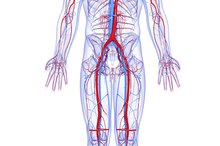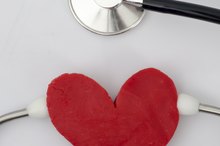The 4 Parts of the Cardiovascular System
The main purpose of the cardiovascular system is to transport blood rich in oxygen and nutrients to cells in the body and transport waste products in the blood to the appropriate system for elimination. The cardiovascular system plays many important roles, including the maintenance of body temperature. Disorders of the cardiovascular system are common and include conditions such as hypertension, heart disease, peripheral artery disease and atherosclerosis.
Heart
According to the Texas Heart Institute, the heart is a continuously pumping muscle—made of four chambers—that beats throughout a person’s lifespan. The heart is essentially a pump that pushes oxygen-rich blood through arteries to tissues, organs and cells, according to the institute. Blood returns to the heart through venules, which are small blood vessels, and veins. Four valves regulate blood flow in the heart from both veins and arteries. The heart, therefore, is the main component of the cardiovascular system that ensures that all veins, capillaries and arteries receive the blood necessary to nourish cells.
Capillaries
How Do the Walls of the Atria & Ventricles Differ?
Learn More
Capillaries are thin and fragile compared with other parts of the cardiovascular system. Because of the small size of these blood vessels, blood cells can pass through only in single file. Capillaries are where the exchange of oxygen and carbon dioxide with cells occurs. According to the Franklin Institute, red blood cells in the capillary release oxygen, which passes through the vessel wall and into surrounding tissues. The tissues release carbon dioxide into the blood cells, completing the exchange.
Arteries
An artery is a type of blood vessel that helps circulate blood in the body. According to the Franklin Institute, the heart pumps blood through the main artery, the dorsal aorta, which subsequently branches into smaller arteries to provide blood to other parts of the body. Arteries have a muscular wall that helps the heart pump blood. The artery expands when the heart beats and contracts when the heart relaxes, helping to push the blood along. Arteries also play a major role in delivering blood rich in oxygen to capillaries, which deliver it to the cells.
Veins
How Do the Walls of the Atria & Ventricles Differ?
Learn More
According to the Franklin Institute, veins and arteries are similar. Veins function by transporting blood through the cardiovascular system at a lower pressure than that in arteries. Veins are made of three layers: outer, inner and smooth. According to the Franklin Institute, blood flows into the veins from capillaries after the exchange of oxygen and carbon dioxide with cells. The veins transport blood to the lungs and the heart. Veins play an important role in helping to keep blood flowing to the heart.
Related Articles
References
Writer Bio
Quentin J. Moore, has been writing since 1999, with articles published in the American Dietetic Association SCAN's Pulse. His expertise focuses on cardiovascular health, nutrition and physical activity. Moore has a Master of Public Health in human nutrition from the University of Michigan School of Public Health.






